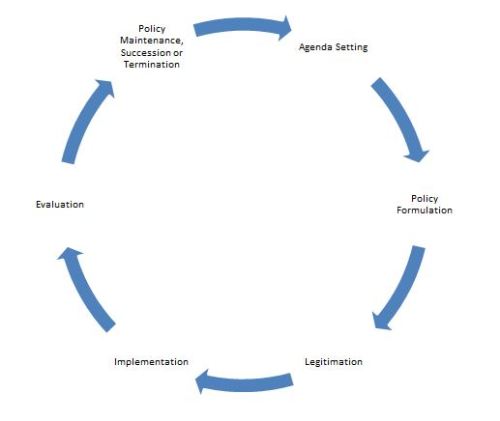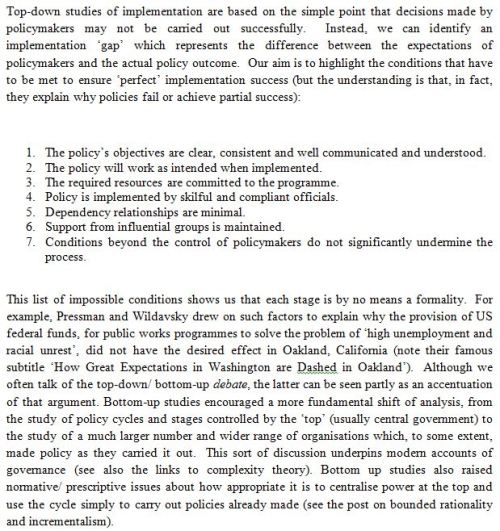See also What is Policy? and the Policy concepts in 1000 words series
The classic way to study policymaking is to break it down into stages. The stages have changed over the years, and vary by country, but the basic ideas remain the same:
- Descriptive. Let’s simplify a complex world by identifying its key elements.
- Prescriptive. Let’s work out how to make policy, to translate public demands into government action (or at least to carry out government policy).
A cycle divides the policy process into a series of stages, from a notional starting point at which policymakers begin to think about a policy problem to a notional end point at which a policy has been implemented and policymakers think about how successful it has been before deciding what to do next. The image is of a continuous process rather than a single event. The evaluation stage of policy 1 represents the first stage of policy 2, as lessons learned in the past set the agenda for choices to be made in the future:
- Agenda setting. Identifying problems that require government attention, deciding which issues deserve the most attention and defining the nature of the problem.
- Policy formulation. Setting objectives, identifying the cost and estimating the effect of solutions, choosing from a list of solutions and selecting policy instruments.
- Legitimation. Ensuring that the chosen policy instruments have support. It can involve one or a combination of: legislative approval, executive approval, seeking consent through consultation with interest groups, and referenda.
- Implementation. Establishing or employing an organization to take responsibility for implementation, ensuring that the organization has the resources (such as staffing, money and legal authority) to do so, and making sure that policy decisions are carried out as planned.
- Evaluation. Assessing the extent to which the policy was successful or the policy decision was the correct one; if it was implemented correctly and, if so, had the desired effect.
- Policy maintenance, succession or termination. Considering if the policy should be continued, modified or discontinued.
The cycle is useful in many ways. It is simple and understandable. It can be applied to all political systems. The emphasis on cycles highlights fluid policymaking. There is also a wide range of important studies (and key debates) based on the analysis of particular stages – such as the top-down versus bottom-up approaches to the study of policymaking.
However, the stages approach is no longer central to policy studies, partly because it does not help explain what it describes, and partly because it oversimplifies a complex world (does it also seem to take the politics out of policymaking? In other words, note the often-fraught politics of seemingly-innocuous stages such as evaluation). The policymaking system may be seen more as a collection of thousands of policy cycles, which interact with each other to produce much less predictable outcomes. Indeed, many of the theories or concepts outlined in this series serve as replacements for a focus on cycles (see the The Advocacy Coalition Framework and Multiple Streams Analysis in particular).
The prescriptive side of cycles and stages is a bit more interesting, because it may be both unrealistic and useful at the same time. Stages can be used to organise policymaking in a simple way: identify policymaker aims, identify policies to achieve those aims, select a policy measure, ensure that the selection is legitimised by the population or its legislature, identify the necessary resources, implement and then evaluate the policy. The academic idea is simple and the consequent advice to policy practitioners is straightforward. It is difficult – but not impossible – to describe a more meaningful, more realistic, analytical model to policymakers (and give advice on how to act) in the same straightforward way.
Related articles
- https://paulcairney.wordpress.com/1000-words/
- For more on the prescriptive side, see How can policy theory have an impact on policymaking? and chapter 2 of The Politics of Evidence-based Policymaking










Pingback: How Big is the Incentive for Politicians to Look Dishonest or Stupid? | Paul Cairney: Politics and Policy
Pingback: How to present policy analysis to many audiences #POLU9SP | Paul Cairney: Politics & Public Policy
Pingback: Political science improves our understanding of evidence-based policymaking, but does it produce better advice? | Paul Cairney: Politics & Public Policy
Pingback: Whatever happened to multiple streams analysis? | Paul Cairney: Politics & Public Policy
Pingback: 12 things to know about studying public policy | Paul Cairney: Politics & Public Policy
good
Pingback: The implementation of policy in Scotland #POLU9SP | Paul Cairney: Politics & Public Policy
Pingback: Can anyone use the ‘tools’ of policy analysis? | Paul Cairney: Politics & Public Policy
great,the work is easily elaborated and easy to digest
Pingback: Westminster is more powerful than you think, but only if you dismiss its importance | Paul Cairney: Politics & Public Policy
Pingback: ‘Evidence-based Policymaking’ and the Study of Public Policy | Paul Cairney: Politics & Public Policy
Pingback: Policy Concepts in 1000 Words: the intersection between evidence and policy transfer | Paul Cairney: Politics & Public Policy
Pingback: Coming to grips with with evidence-based policymaking: what do we need to know? | The Power To Persuade
Pingback: Policy in 500 Words: if the policy cycle does not exist, what do we do? | Paul Cairney: Politics & Public Policy
Pingback: British politics, Brexit and UK sovereignty: what does it all mean? #POLU9UK | Paul Cairney: Politics & Public Policy
Pingback: Policymaking in the UK: do you really know who is in charge and who to blame? #POLU9UK | Paul Cairney: Politics & Public Policy
Pingback: Writing a policy paper and blog post #POLU9UK | Paul Cairney: Politics & Public Policy
Pingback: The Science of Evidence-based Policymaking: How to Be Heard | Paul Cairney: Politics & Public Policy
Pingback: Why doesn’t evidence win the day in policy and policymaking? | Paul Cairney: Politics & Public Policy
Pingback: The obvious politics of reform – Hannah and development politics
Pingback: The Cornell Policy Review | 30 Days of Demonetization in India
Pingback: Tips for policy success: learn from ‘policy entrepreneurs’ and exploit ‘windows of opportunity’ | Paul Cairney: Politics & Public Policy
Pingback: Policy in 500 Words: Multiple Streams Analysis and Policy Entrepreneurs | Paul Cairney: Politics & Public Policy
Pingback: Policy concepts in 1000 or 500 words | Paul Cairney: Politics & Public Policy
Pingback: Policy Concepts in 500 Words: The Policy Process | Paul Cairney: Politics & Public Policy
Pingback: Policy Concepts in 1000 Words: The Policy Process | Paul Cairney: Politics & Public Policy
Pingback: Evidence based policymaking: 7 key themes | Paul Cairney: Politics & Public Policy
Pingback: A 5-step strategy to ‘make evidence count’* | Paul Cairney: Politics & Public Policy
Pingback: Why don’t policymakers listen to your evidence? | Paul Cairney: Politics & Public Policy
Pingback: Three habits of successful policy entrepreneurs | Policy and Politics Journal
Pingback: The Politics of Evidence-Based Policymaking: ANZSOG talks | Paul Cairney: Politics & Public Policy
Pingback: Collective Impact is Hard, But We're Not In the Dark: Part 3 - Policy Change - Visible Network Labs
Pingback: Conceptos de política pública en 1000 palabras: El ciclo de la política pública y sus etapas | Paul Cairney: Politics & Public Policy
Pingback: Policy Analysis in 750 words: Michael Mintrom (2012) Contemporary Policy Analysis | Paul Cairney: Politics & Public Policy
Pingback: In the throws of policy – activatelearningpgce
Pingback: Policy Analysis in 750 words: the old page | Paul Cairney: Politics & Public Policy
Pingback: Policy Analysis in 750 Words: What can you realistically expect policymakers to do? | Paul Cairney: Politics & Public Policy
Pingback: Policy Analysis in 750 Words: what you need as an analyst versus policymaking reality | Paul Cairney: Politics & Public Policy
Pingback: Ecologists engaging with policy – what have we learnt? – Nature Futures Australia
Pingback: Policy Analysis in 750 Words: How to deal with ambiguity | Paul Cairney: Politics & Public Policy
Pingback: Tools for climate policy (3): six effects of art in policy - Policy Lab
Pingback: Tools for climate policy (3): six effects of art in policy – Policy Lab | Public Sector Blogs
Pingback: Tools for climate policy (3): six effects of art in policy – 321update: UK News – The latest headlines
Pingback: Using policy theories to interpret public health case studies: the example of a minimum unit price for alcohol | Paul Cairney: Politics & Public Policy
Pretty informative!
Pingback: Chapter 2. Perspectives on Policy and Policymaking | Paul Cairney: Politics & Public Policy